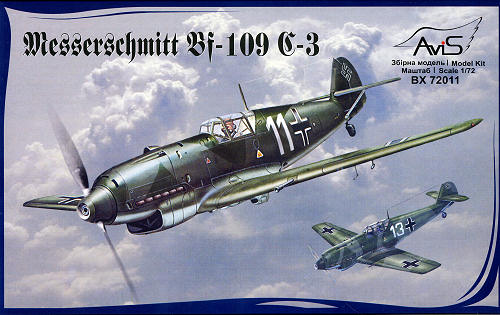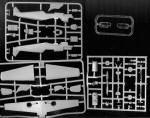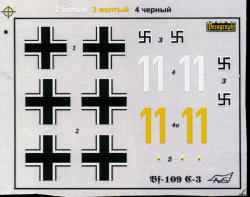
Avis 1/72 Bf-109C-3
| KIT #: | 72011 |
| PRICE: | $14.95 from http://www.scale-model-kits.com |
| DECALS: | One Option |
| REVIEWER: | Scott Van Aken |
| NOTES: |

| HISTORY |
The second full production version of the Bf-109 was developed from two prototypes. The Bf 109 V8 was constructed to test the fitting of two more machine guns in the wings. Results showed that the wing needed strengthening. In the following V9 prototype both wing guns were replaced by 20 mm MG FF cannons.
The short-lived Bf 109C ("Caesar") was powered by a 700 PS Jumo 210G engine with direct fuel injection. Another important change was a strengthened wing, now carrying two more machine guns giving four 7.92 mm (.312 in) MG 17s in total. The C-0 were pre-production aircraft, the C-1 was the production version, the C-2 an experimental version with an engine-mounted machine gun. The C-3 had 20 mm MG FF cannons replacing the two MG 17s in the wings but its not known how many C-3 were built or converted. The C-4 was planned to have an engine-mounted MG FF, but the variant was not produced.
A total of 58 Bf 109C of all versions were built by Messerschmitt.
| THE KIT |
 Looking
at the sprues for this kit, you'd think that it was the same as the
previously reviewed 109D-1. Almost. The instructions state that
this is a limited edition kit, which to most of us means short run and it
very much appears to be just that. The somewhat soft light grey plastic is
molded on three somewhat thick sprues. One clear sprue carried two somewhat
thick single piece canopies.
Looking
at the sprues for this kit, you'd think that it was the same as the
previously reviewed 109D-1. Almost. The instructions state that
this is a limited edition kit, which to most of us means short run and it
very much appears to be just that. The somewhat soft light grey plastic is
molded on three somewhat thick sprues. One clear sprue carried two somewhat
thick single piece canopies. run kit. Many of these gates run
onto the part itself so will need to be carefully cut free and sanded. This
is, after all, a low pressure short run kit so one expects these things. I
did find but one sink area, that being on t
run kit. Many of these gates run
onto the part itself so will need to be carefully cut free and sanded. This
is, after all, a low pressure short run kit so one expects these things. I
did find but one sink area, that being on t he fuselage opposite some cockpit
interior detail. Easy enough to fill and sand. The difference between this
and the D-1 kit is the lower wing, which has the bulges for the cannon
molded in place.
he fuselage opposite some cockpit
interior detail. Easy enough to fill and sand. The difference between this
and the D-1 kit is the lower wing, which has the bulges for the cannon
molded in place. | CONCLUSIONS |
OK, so another interesting early 109. It may be a speculative scheme, but then it may be one that was used operationally; there is no definitive record one way or the other. I'm hesitant to agree with the single solid upper surface color as that was not the norm, but I've also learned that saying 'never' will only get on into trouble when it comes to Luftwaffe camo!
| REFERENCES |
http://en.wikipedia.org
June 2009
Thanks to
http://www.scale-model-kits.com
for the review kit. Get yours at the link.
If you would like your product reviewed fairly and quickly, please
contact
me or see other details in the
Note to
Contributors.